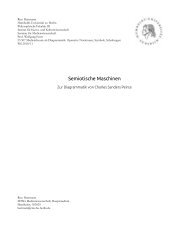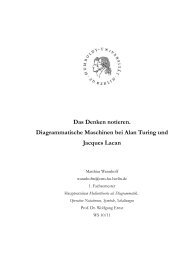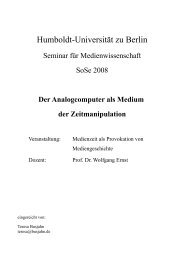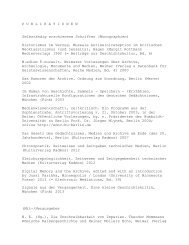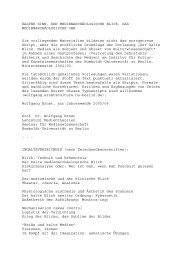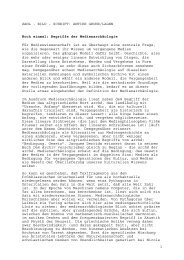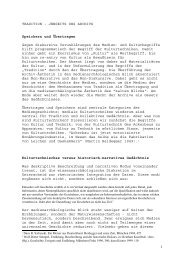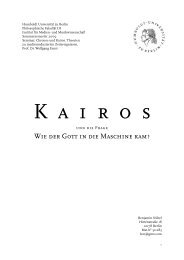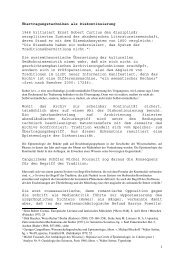Download - Medienwissenschaft
Download - Medienwissenschaft
Download - Medienwissenschaft
Create successful ePaper yourself
Turn your PDF publications into a flip-book with our unique Google optimized e-Paper software.
In an age when the difference between original and copy becomes increasingly<br />
meaningless, it seems appropriate to observe the cognitive process by which a phenomenon<br />
is perceived as authentic. This would be the transition from an authenticity of the<br />
work (substance-based logic) to an authenticity of observation (process-based logic). 11<br />
And yet, authenticity is not just a category of observation, but also a function of<br />
technological materials.<br />
The Media Law of the Original<br />
The other guarantor of the notion of the original is the law: the legal discourse is interested<br />
in the direct links between originality and contractual rights. One answer of the art<br />
market, which has an interest in the continuation of an economy based on the original,<br />
is the hybrid of the original edition: one of its institutional guarantors is the museum as<br />
a medium for the systematic limitation of works and their reproduction. The trace of the<br />
aura is inscribed on the juridical notion of the original when - as in the discourse of mediaeval<br />
reliquary cults - tactility becomes the authority of the reproduction - a criterion<br />
that is itself technological: "Everything produced from the original plaster is a cast, an<br />
edition; everything not produced from the original plaster is a reproduction."<br />
But what makes a digital image an original, what a copy? Does the answer to this<br />
question depend on the degree of digital resolution when scanning, comparable to the<br />
television copyright category of transmittable material. Copiers, fax machines and scanners<br />
were exempt from copyright fees when they managed less than two pages per minute,<br />
with the effect that computer manufacturers kept the output of their machines artificially<br />
low (so users went abroad to acquire faster drives). "Last week, these brakes to<br />
digital progress have been removed." 12 Digital sampling - whether in the area of acoustics<br />
or optics - makes the media-archaeologically radical difference between analogue<br />
and digital obvious - with regard to quotation rights. We have to remember that it was<br />
the magnetic tape (audio and video) which made it possible for radio and television, original<br />
media of broadcasting and transmission, to find their way into the cultural memory,<br />
because it allowed storage. And this includes individual artistic practice such as the<br />
Loops of the video artist Klaus vom Bruch:<br />
I stole images from television and, from them I created my personal archive with<br />
which to work iconographically. The archive is my resource for a picture machine. The war<br />
pictures, for instance, reached back to a time before my own. I reached into the archive<br />
for pictures full of history. 13<br />
Thus, what is at stake is the cognitive difference between original and fake. Hans<br />
Ulrich Reck describes the television effects of an aesthetics of video clips, using the<br />
example of a video of the shooting of the Rumanian dictator Ceaucescu at the end of<br />
1989, which suggested a real-time broadcast although they were actually a media fake.<br />
But it is the fake which represents the reality of these media. And this is why the<br />
accusation of non-authenticity is no longer justified. Where the genuine is missing, it makes<br />
no sense to speak of the false. 14 - 150 -



